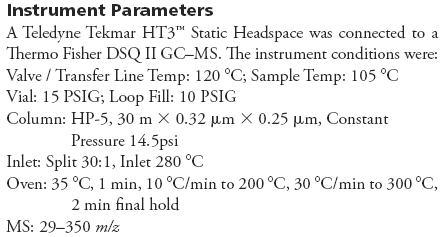Headspace Assay of Water Based Interior Paint with Teledyne Tekmar HT3 Static Headspace Instrument
Volatile organic compounds (VOCs) are one chemical group that has been linked to increase ozone levels. When present in indoor spaces at high enough levels they can produce sick building syndrome symptoms in people.
Roger Bardsley, Teledyne Tekmar
Volatile organic compounds (VOCs) are one chemical group that has been linked to increase ozone levels. When present in indoor spaces at high enough levels they can produce sick building syndrome symptoms in people. One source that adds VOCs to these environments is paint. Recently the EPA has changed the allowable VOCs in paint effective January 1, 2009 (1).
The EPA final rule referenced the California Air Resources Board Method 310 which allows the use of EPA Method 8260B for VOCs. Method 8260B allows headspace for the determination of VOCs in sample matrixes.
A Teledyne Tekmar HT3™ headspace method was used to show the differences in six commercial water based latex paint samples and simple sample preparation.

Sample Preparation
Six commercially available water-based acrylic latex paint samples were obtained. A pre-2009 paint label VOC was 145 g/L. A similar paint post-2009 paint label VOC was 41 g/L. The remaining paint label VOCs were 83 g/L, 40 g/L, and 0 g/L. 1 g of each paint sample was weighed into 22 mL headspace vials.
Data
The total ion current chromatogram (TIC) for the six various paints are presented in Figure 1.

Figure 1
The peak at 8.2 mm was identified as a glycol ether listed on the pre-2009 label, but not the other five samples. This peak showed a drastic decrease from the pre-2009 paint to post-2009 paint. This data is graphed in Figure 2 versus the label VOC concentration.

Figure 2
Conclusion
Headspace analysis was able to differentiate paint formulations from the pattern of compound detected with the headspace/GC–MS method.
The Teledyne Tekmar HT3™ Static Headspace method provided a quick easy method for the determination of VOC components of paint samples. Sample preparation was minimal with the sample being weighed directly into the headspace vial.
References
(1) National Volatile Organic Compound Emission Standards for Aerosol Coatings: Final Rule, March 24,2008, 40 CFR Parts 51 and 59, Environmental Protection Agency, Part III.

Teledyne Tekmar
4736 Socialville Foster Road, Mason, OH 45040
tel. (800)874-2004; fax (513)229-7050
Website: www.teledynetekmar.com

Separation of Ultra-Short and Long Chain PFAS Compounds Using a Positive Charge Surface Column
December 11th 2024A separation of ultra-short and long chain PFAS (C1-C18) is performed on a HALO®PCS Phenyl-Hexyl column along with a HALO®PFAS Delay column which demonstrates excellent retention for both hydrophilic and hydrophobic analytes.














